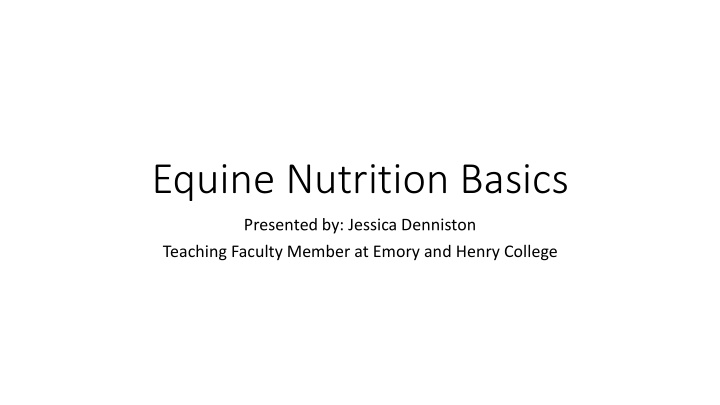



Equine Nutrition Basics Presented by: Jessica Denniston Teaching Faculty Member at Emory and Henry College
Digestive System Overview
Foregut Stomach and Small Intestine Stomach: 3 gallons SI: 20 gallsons
Hindgut Cecum, large intestine Cecum: 12 gallons LI: 32 gallons
For oregut Fu Functio ions Enzymes in the foregut digest: • Fat • Protein • Sugar/Starch
Hindgut Fu Functio ions Fermentation is utilized to break down fiber in the hindgut.
Water The most important nutrient! Functions: • Body temp regulator • Part of all body fluids • Transports nutrients into cells and takes waste out of cells • Required for chemical reactions in metabolism
Protein Functions: • New tissue development (growth phase) • Repair and development of muscle tissue (working phase) Soybean plants: image source agclassroom.org
Carbohydrates Functions: • Energy • Glycogen (stored energy made from unused glucose ) Alfalfa photo source: Standlee
Fat Source of energy! • Plays a role in skin health and coat Functions: condition • Source of essential fatty acids • Aids in absorption and transport of fat • Component of cell membranes soluble vitamins (A,E,D,K)
Vit itamins and Min inerals Vitamins Vitamins (Cont.) • Vitamins A,D,E,K,C • Vitamin B12 • Thiamine (B1) • Niacin • Riboflavin (B2) • Pyridoxine (B6) • Panthothenic Acid (B3) • Choline • Folic Acid • Biotin
Minerals Trace Minerals • Calcium • Cobalt • Phosphorus • Copper • Sodium • Fluoride • Chloride • Iodine • Potassium • Iron • Magnesium • Manganese • Sulfur • Selenium • Zinc
Deciding on a die iet for your equine
Age Considerations • Horses between birth and age 2 are considered to be in the growth stage • Senior horses will have different dietary needs. It is especially important to consider the horse’s ability to properly chew grain and roughage.
Lif Life Stage Consid ideratio ions Exercise Levels: Life Stages: • Breeding • Maintenance • Growth • Moderate • Lactation • Heavy and Very Heavy • Competition (see exercise)
Medic ical l Needs It is important to consider all medical needs of your horse or pony when deciding on a diet. Some major diagnosis to consider are: • Allergies • HYPP • Cushings disease • Obesity Be sure to work with your vet to develop a safe diet for your horse or pony!
Body Condition Score/Weight Utilizing the Henneke Body Condition Score (1-9 scale) determine what score your horse or pony is on the scale to determine if the condition is ideal or if the equine needs to gain or lose weight. Body weight itself is not a great way to determine whether weight should be gained or lost.
Acc ccess and Quality of f Roughage • Consider the number of hours of turnout • The growth stage of the grass • The season • The quality and type of hay • The amount available (hay or pasture) • The specific needs of your horse or pony
Be sure to ch check ck out t Emory and Henry ry College’s Equine Studies program! • Why Equine Studies at E&H? • Riding! Learning! Research! • Students at Emory & Henry participate in hands-on learning through unique research and work opportunities, from performing equine health-related research studies to assisting in running collegiate horse shows. • The equestrian center boasts an environment of professionalism, but is a comfortable atmosphere that cultivates learning, dedication, success both in and out of the arena and inclusion of everyone that is centered around our love of the horses and the equestrian sports
Intermont Equestrian at Emory and Henry College 20432 Stables Rd. Bristol, VA 24202 www.ehc.edu
Recommend
More recommend